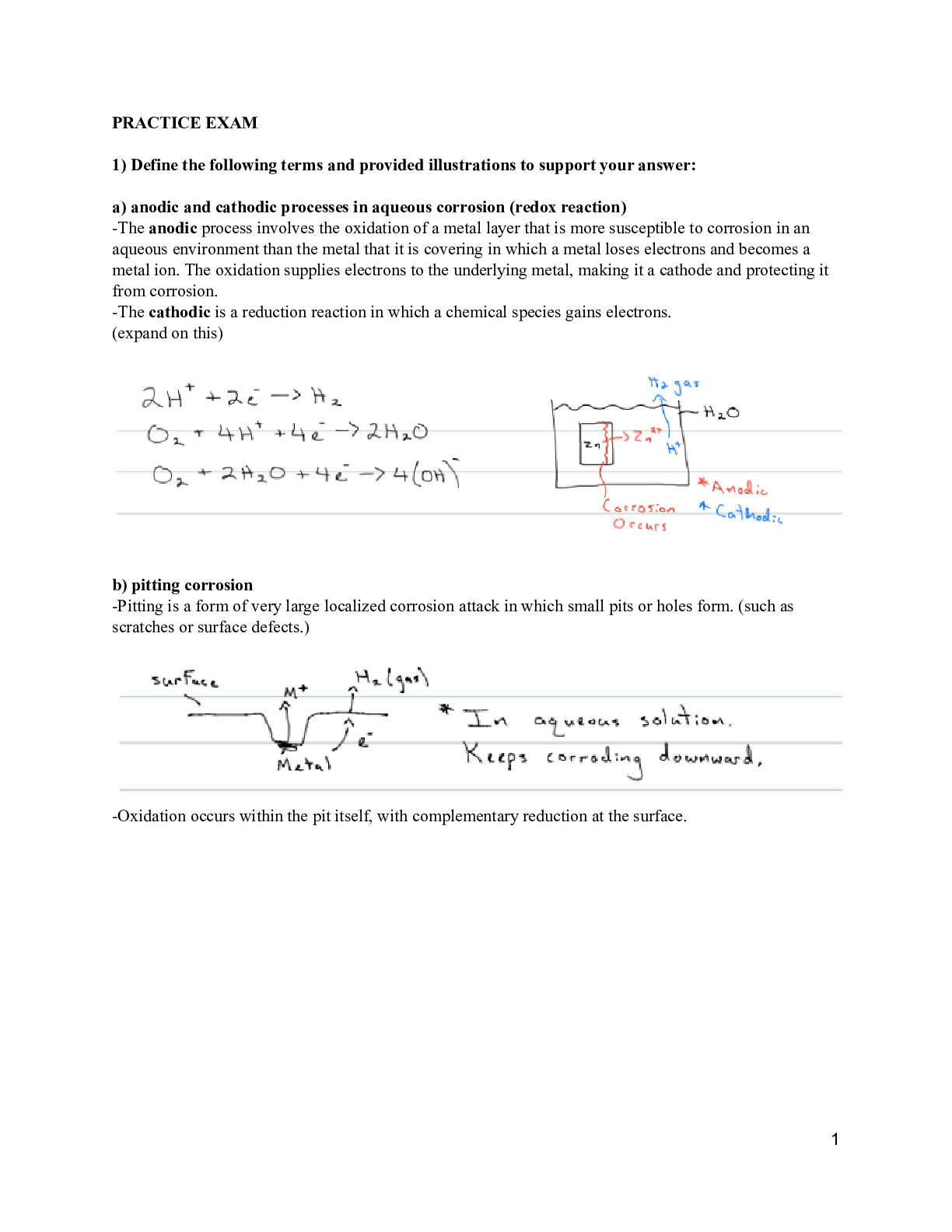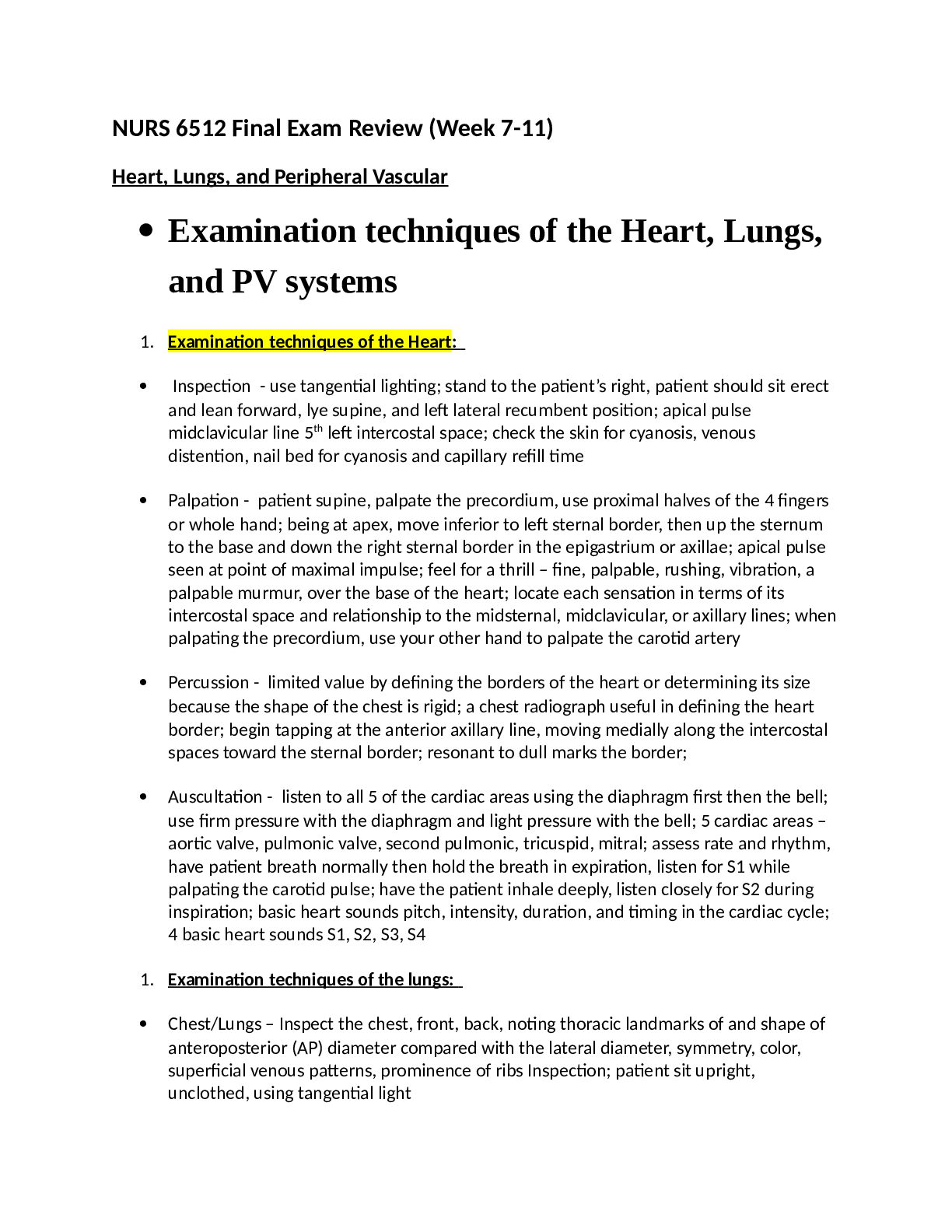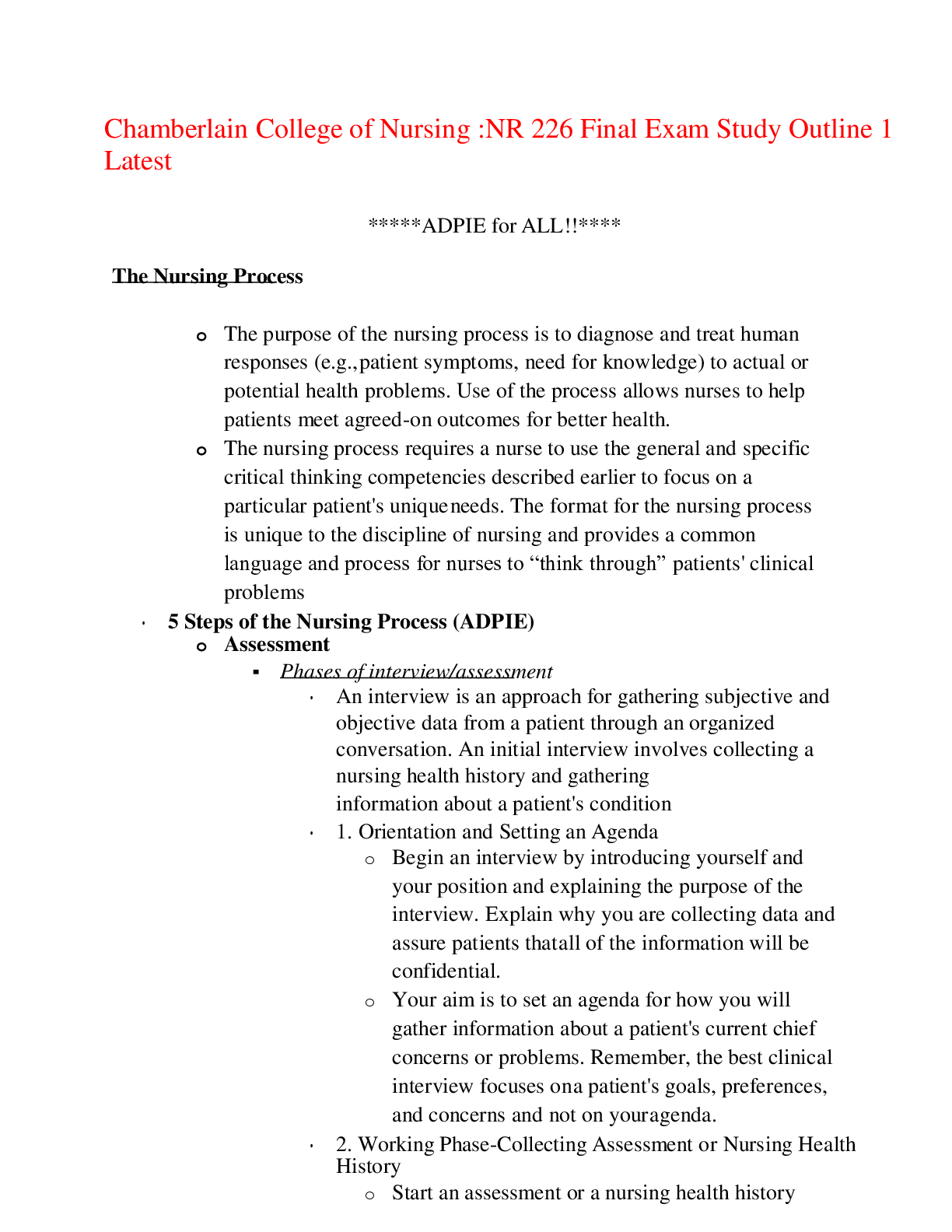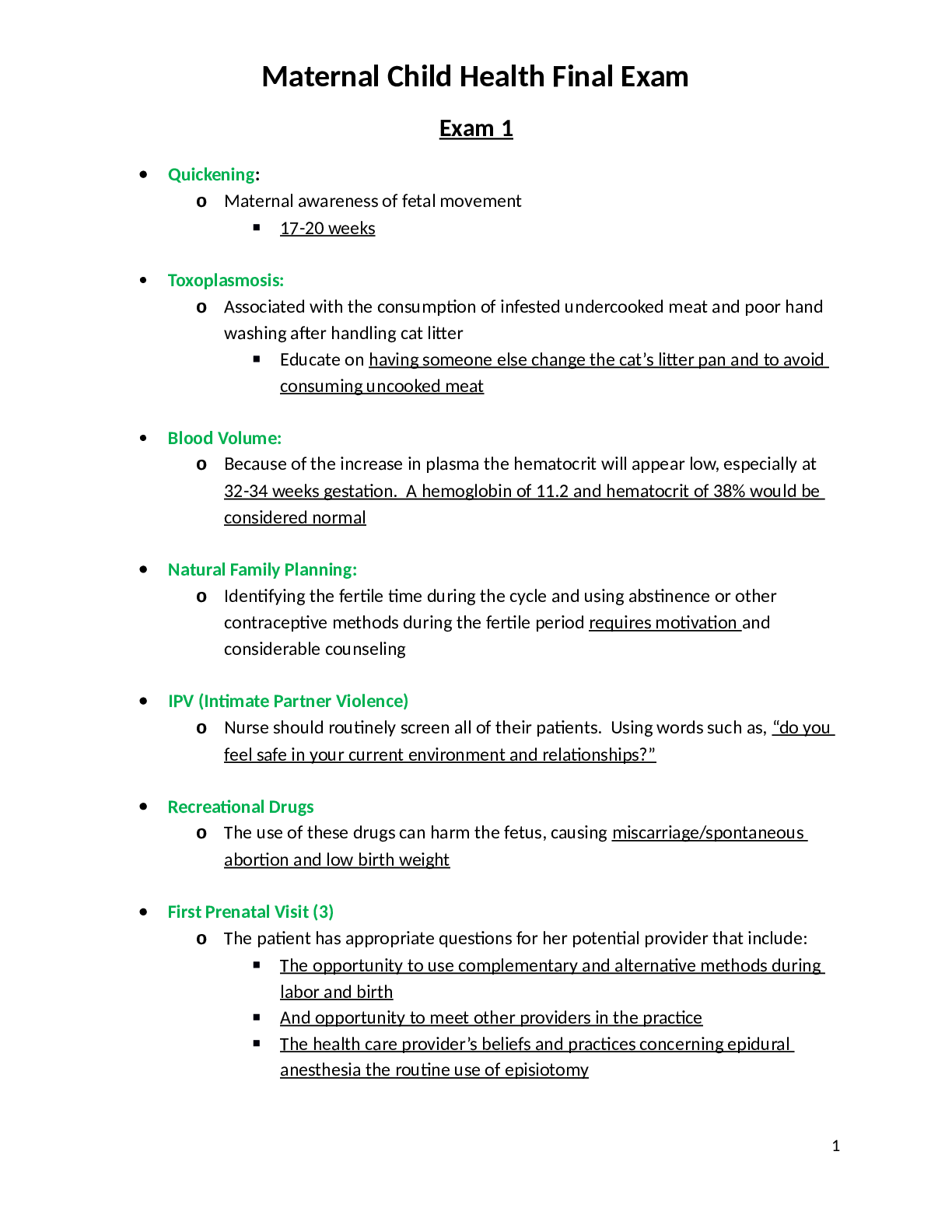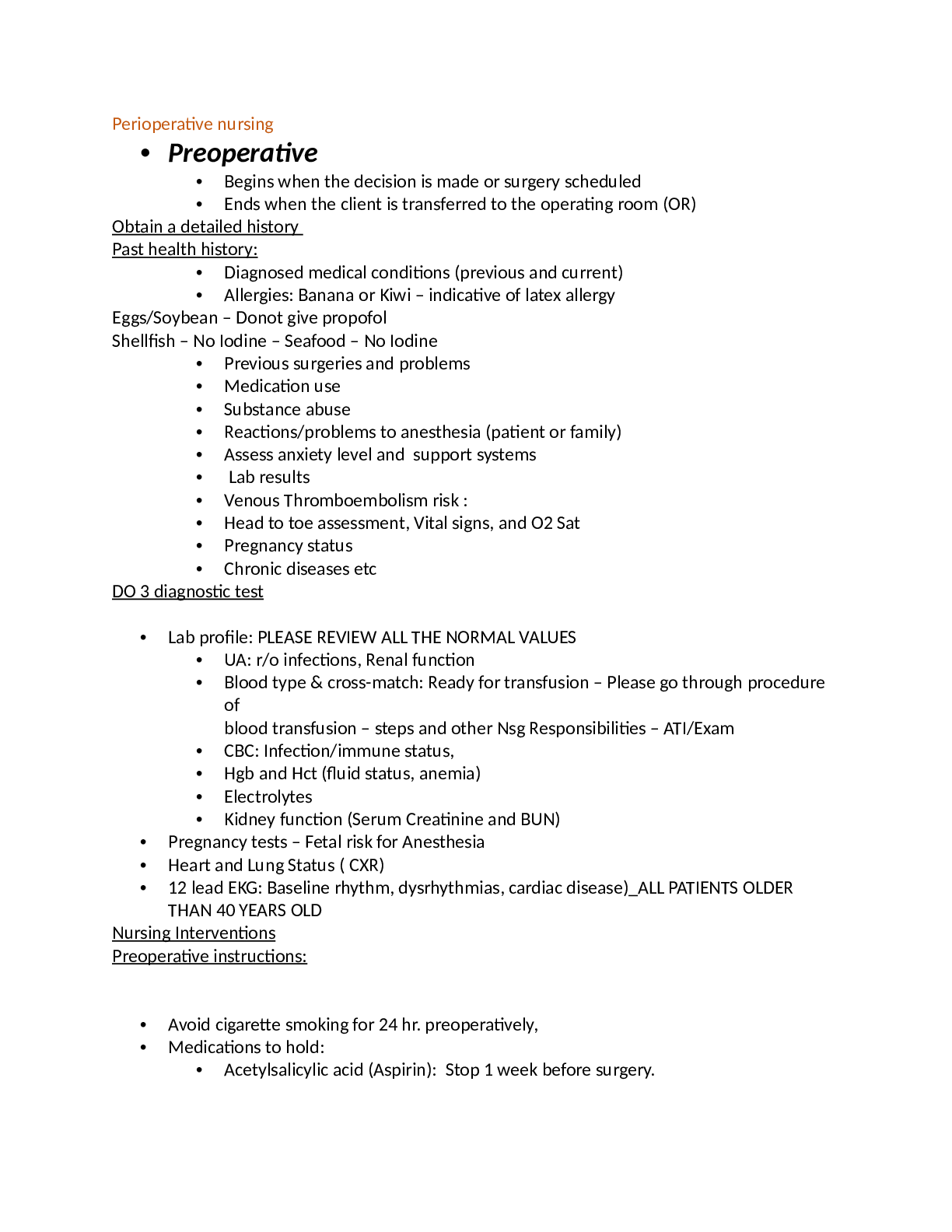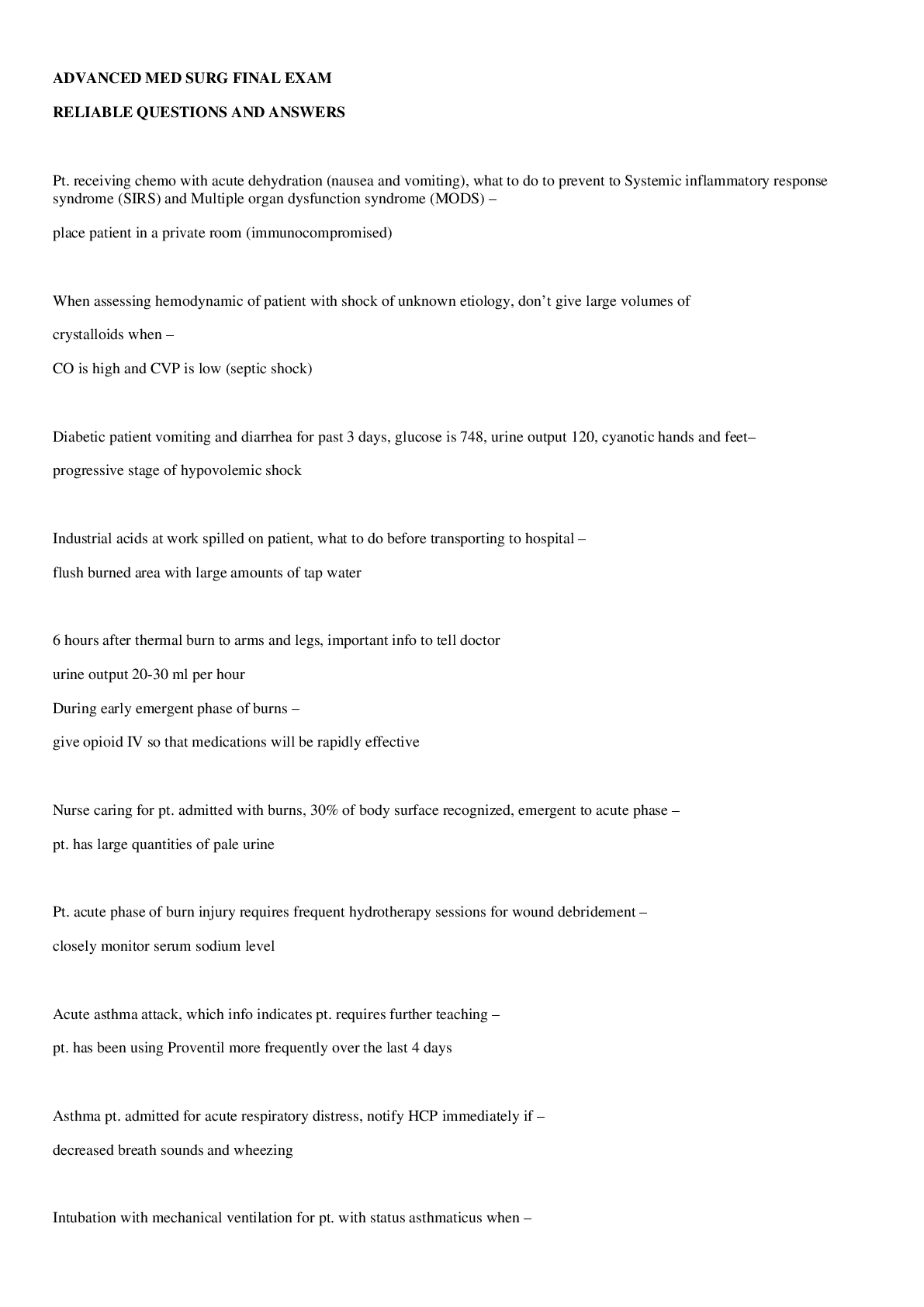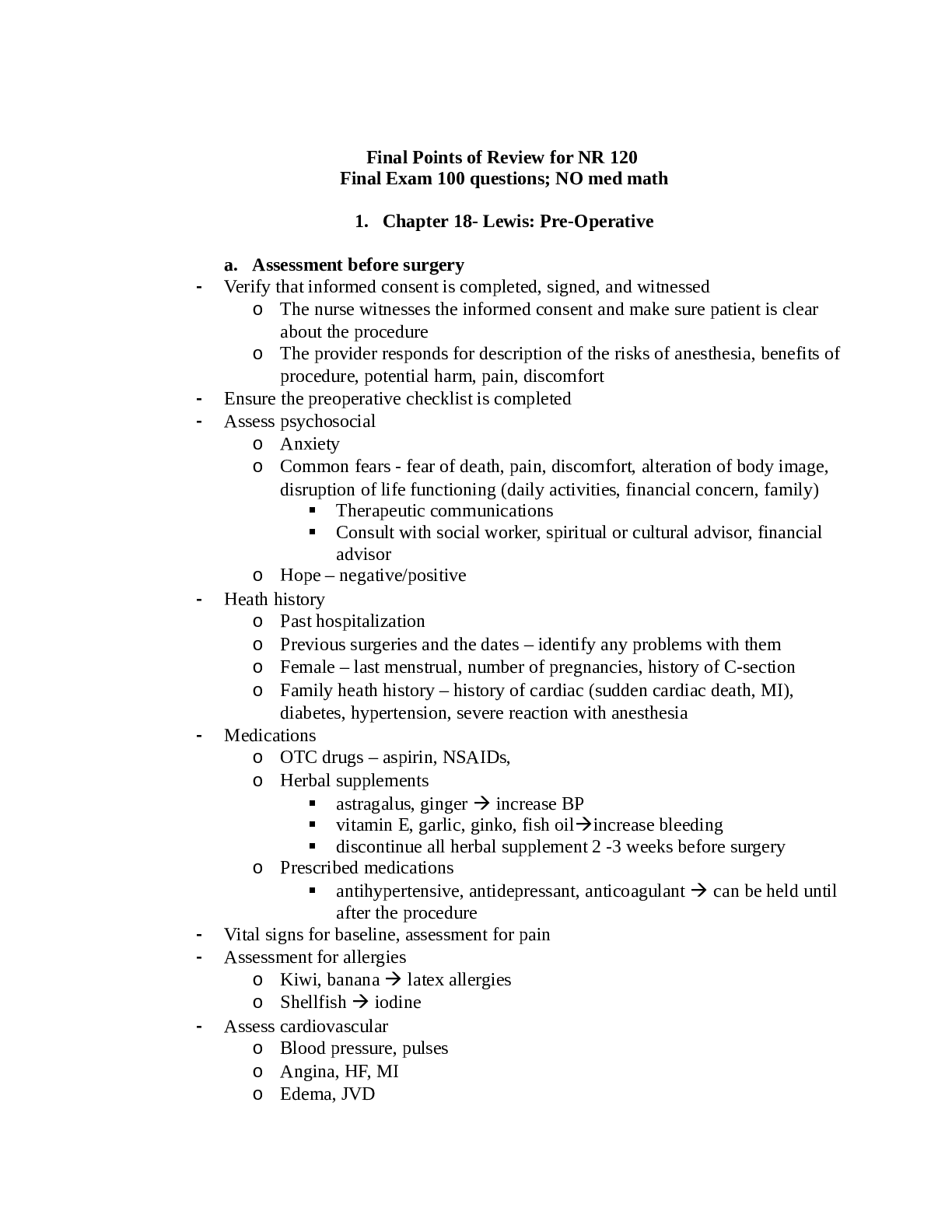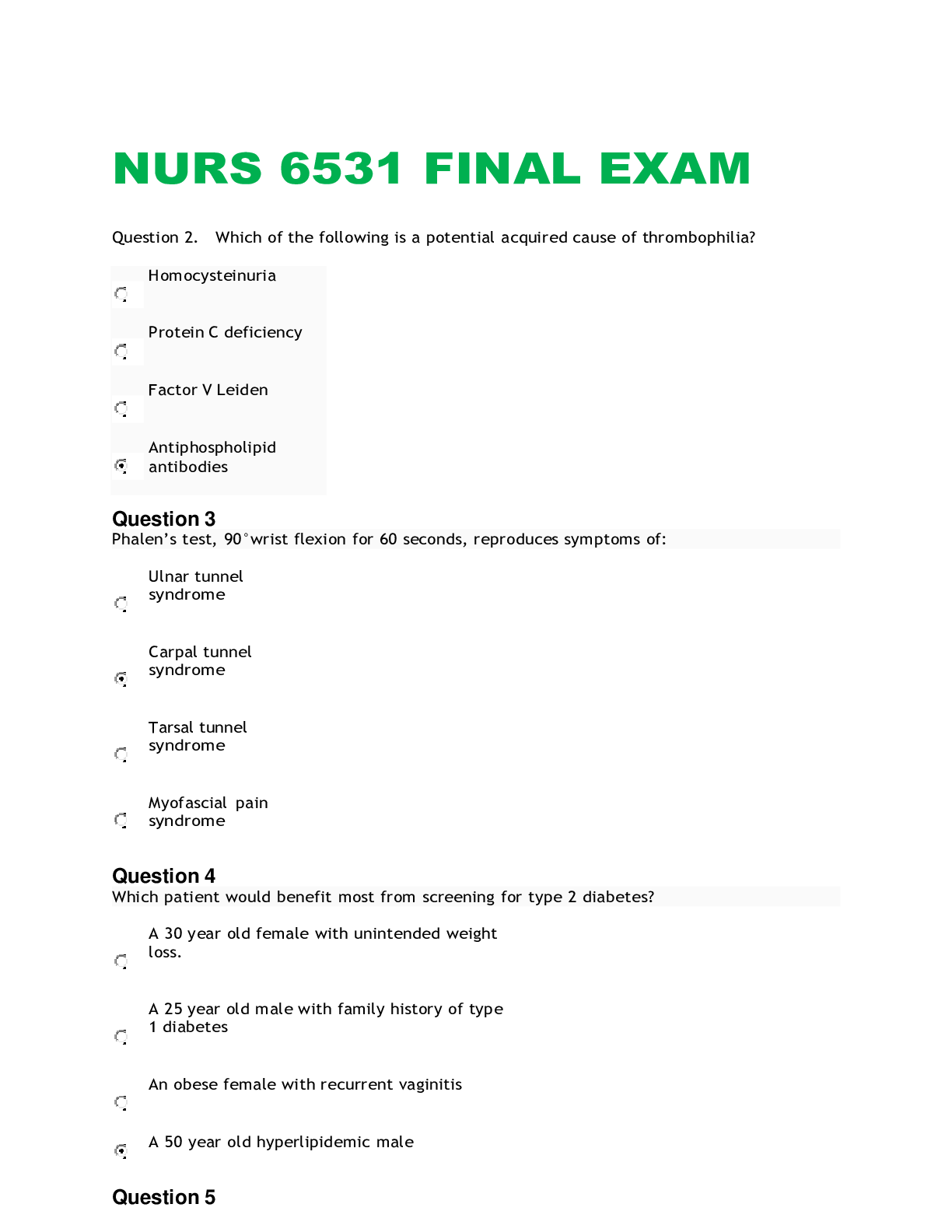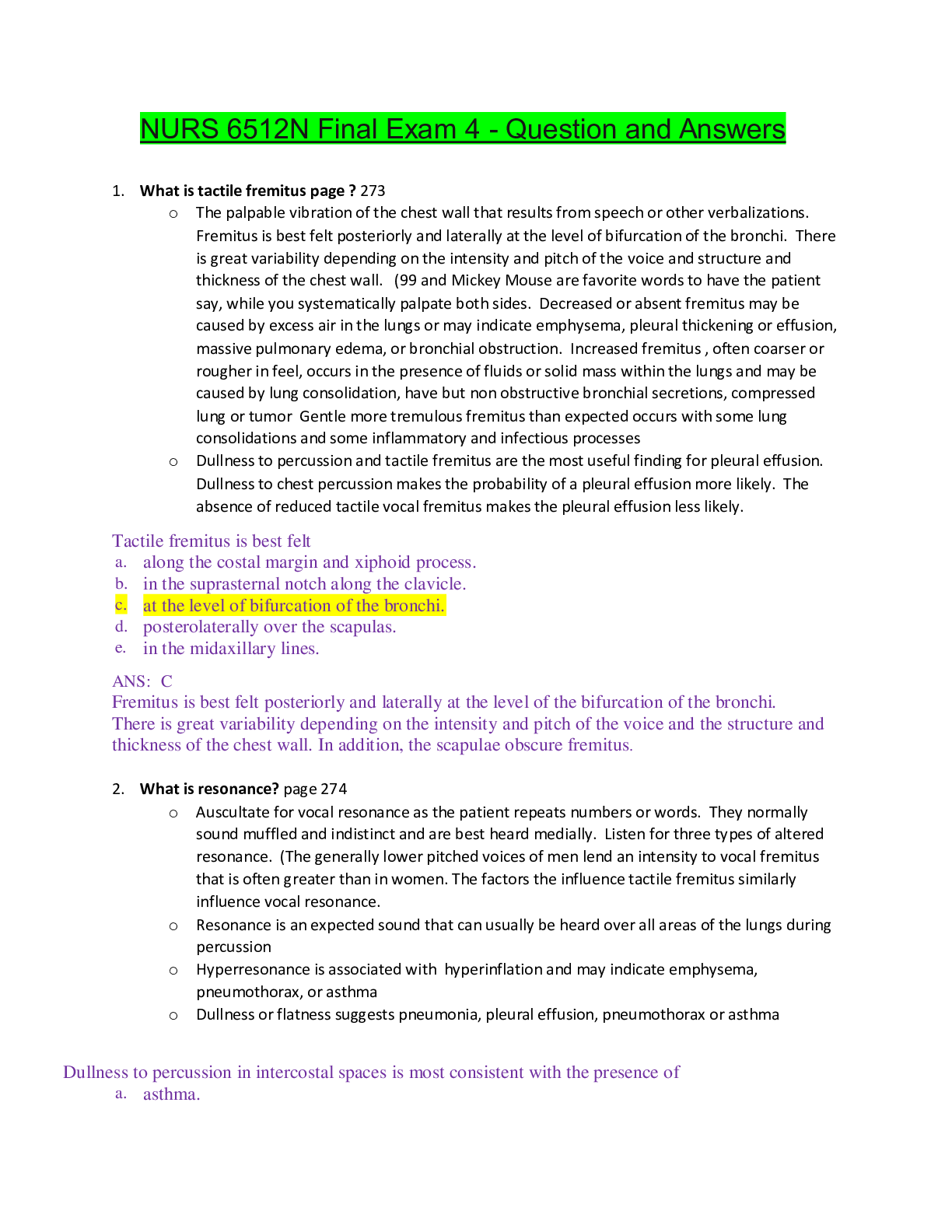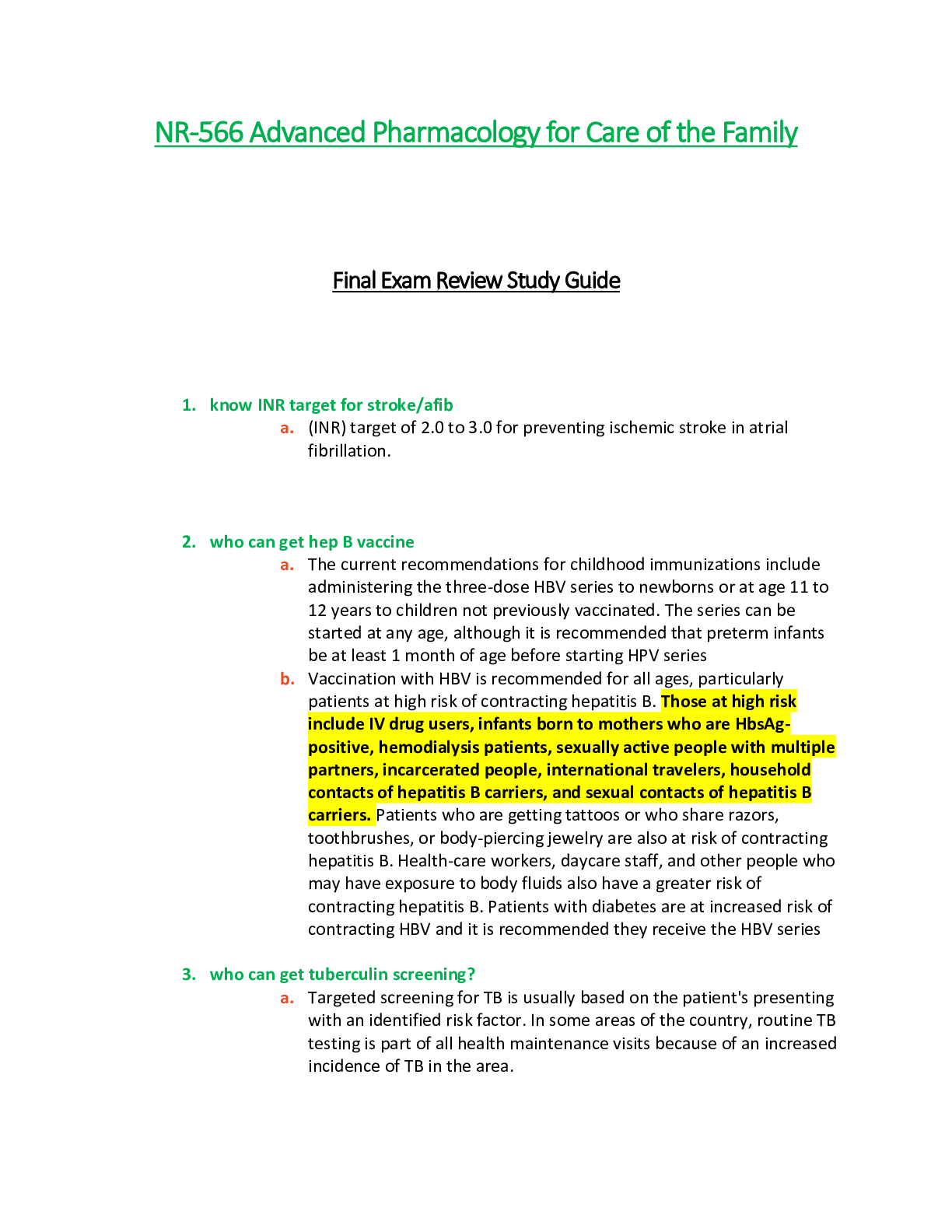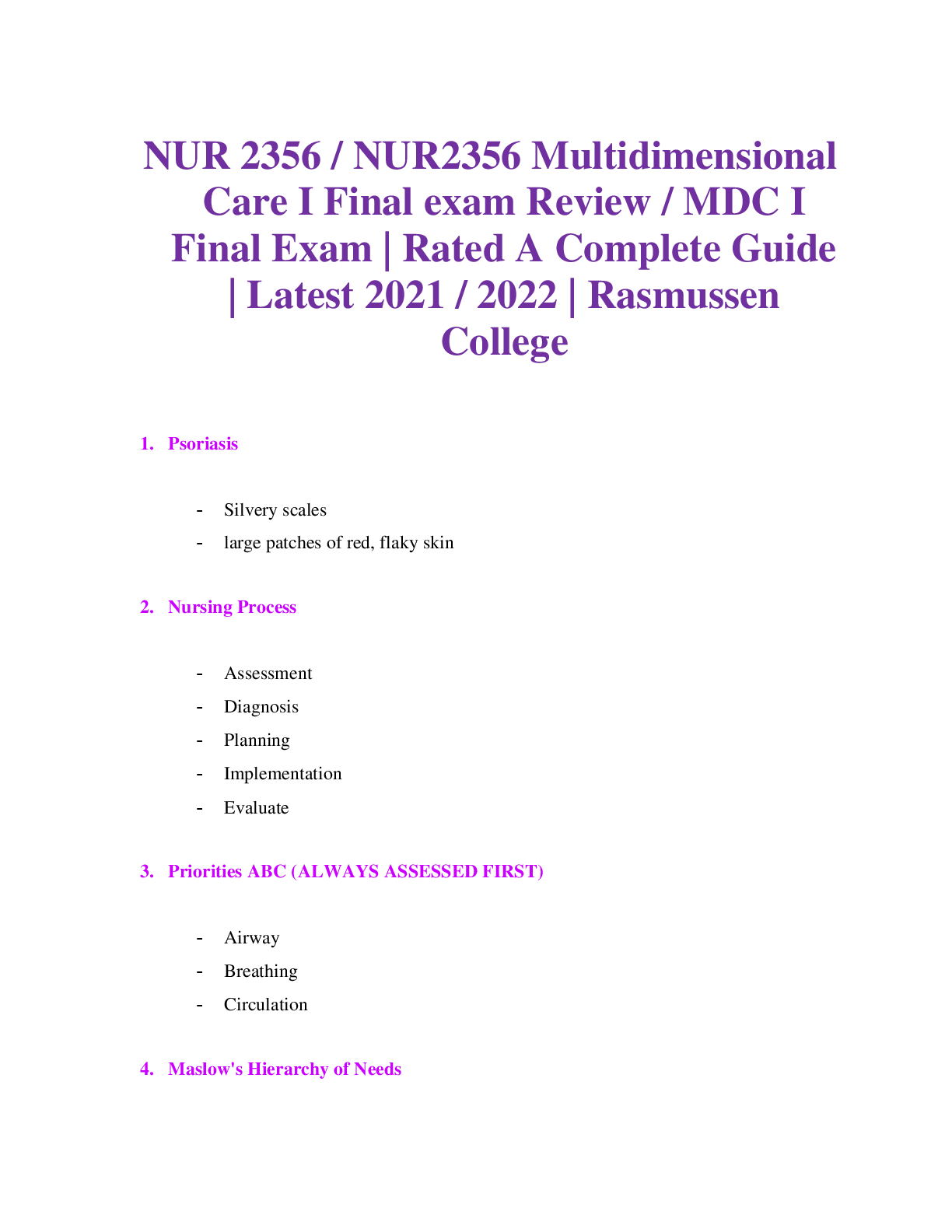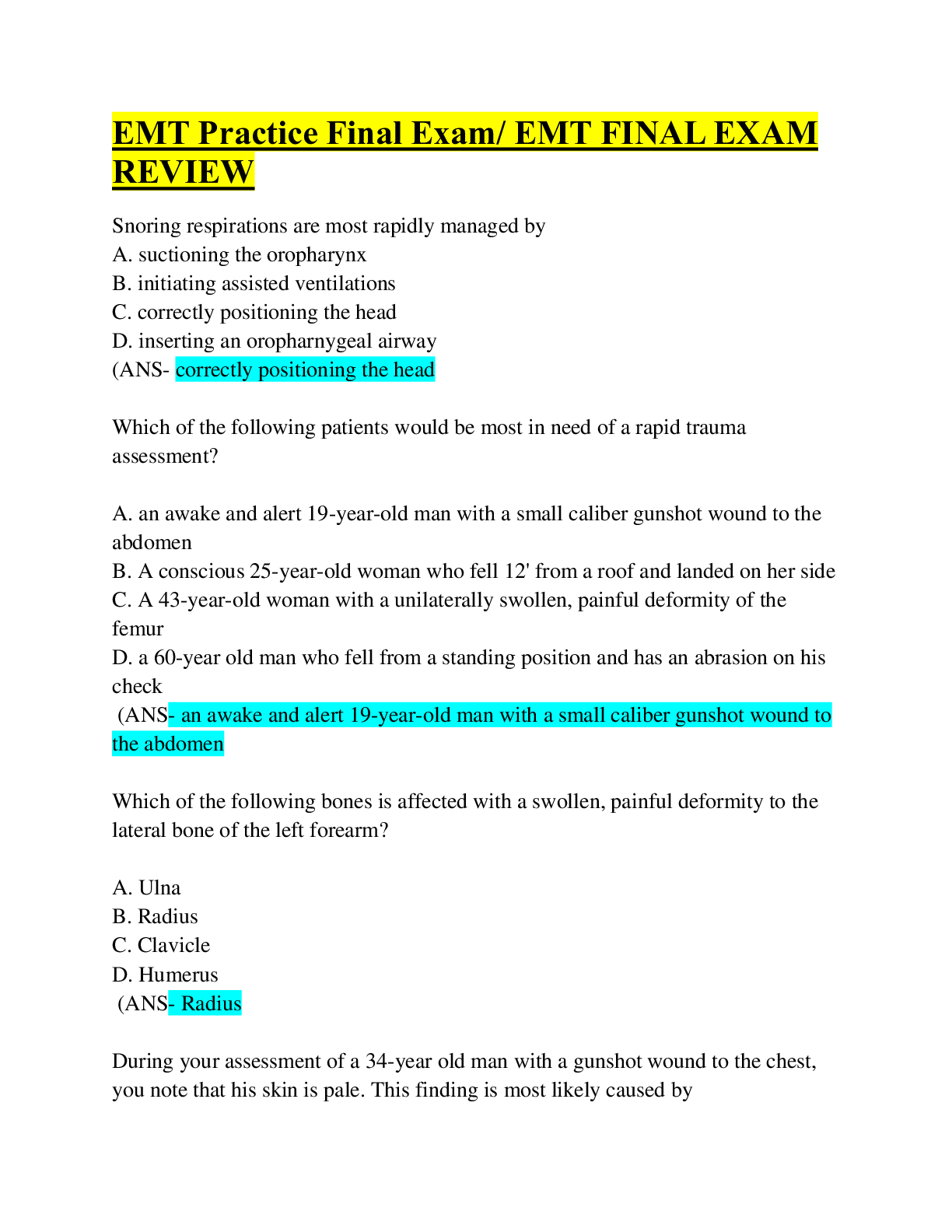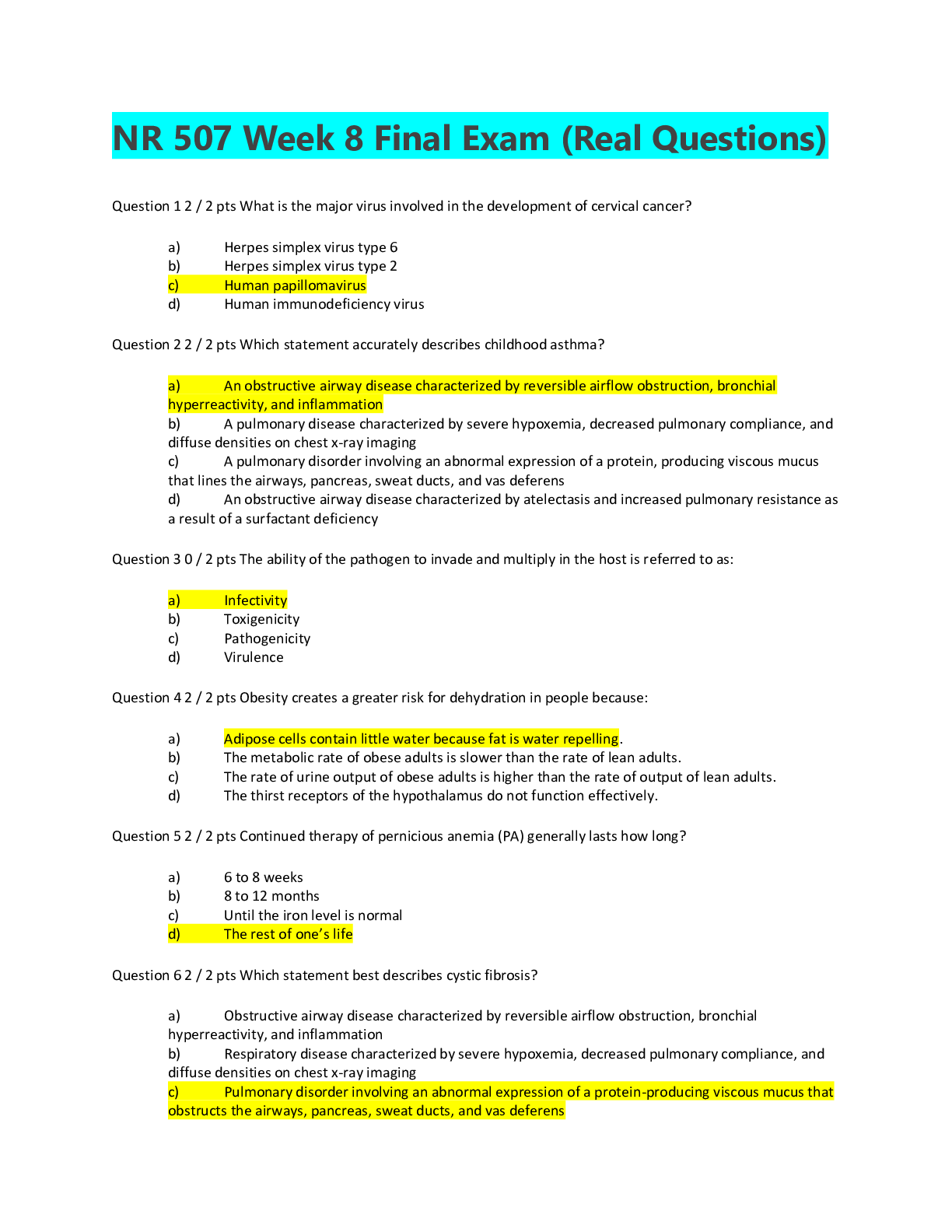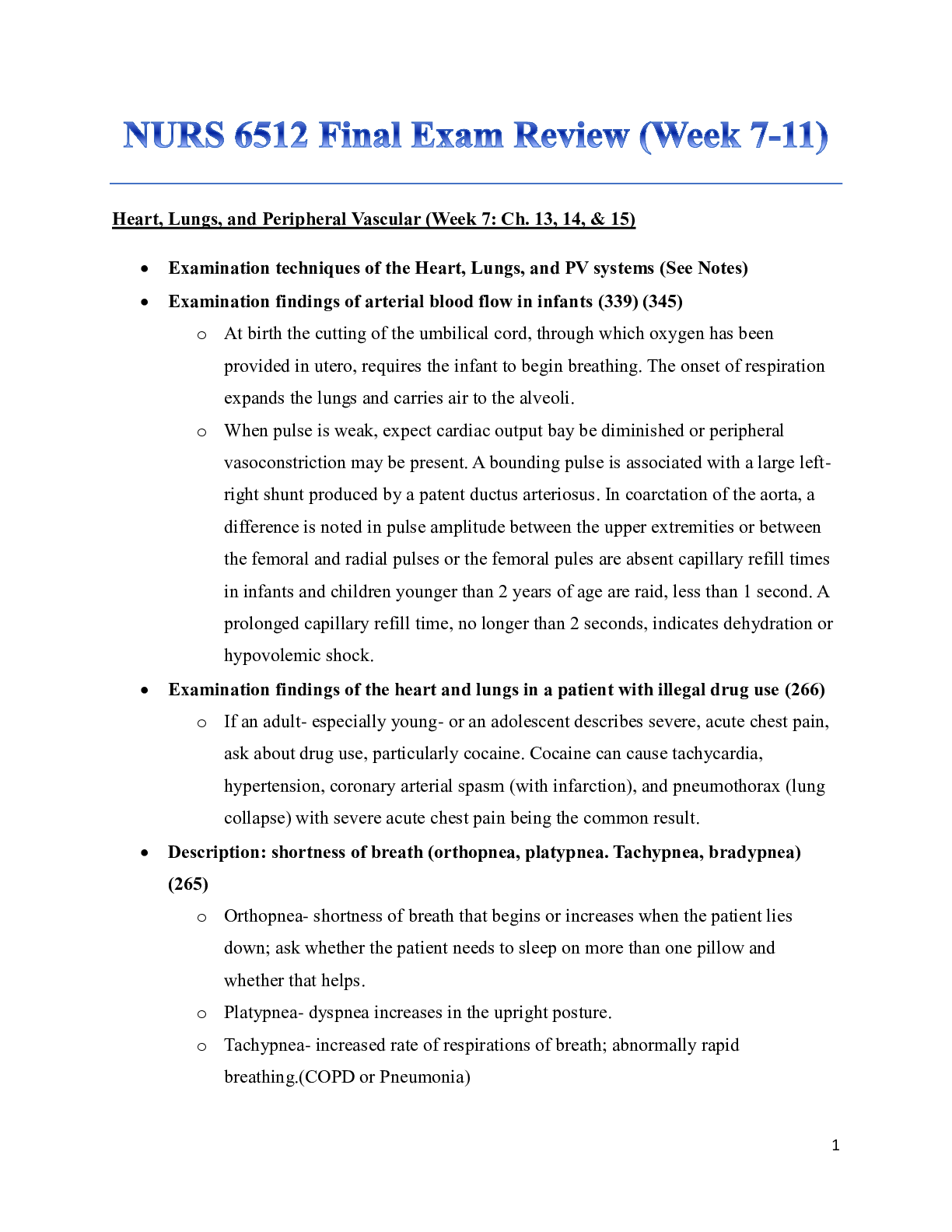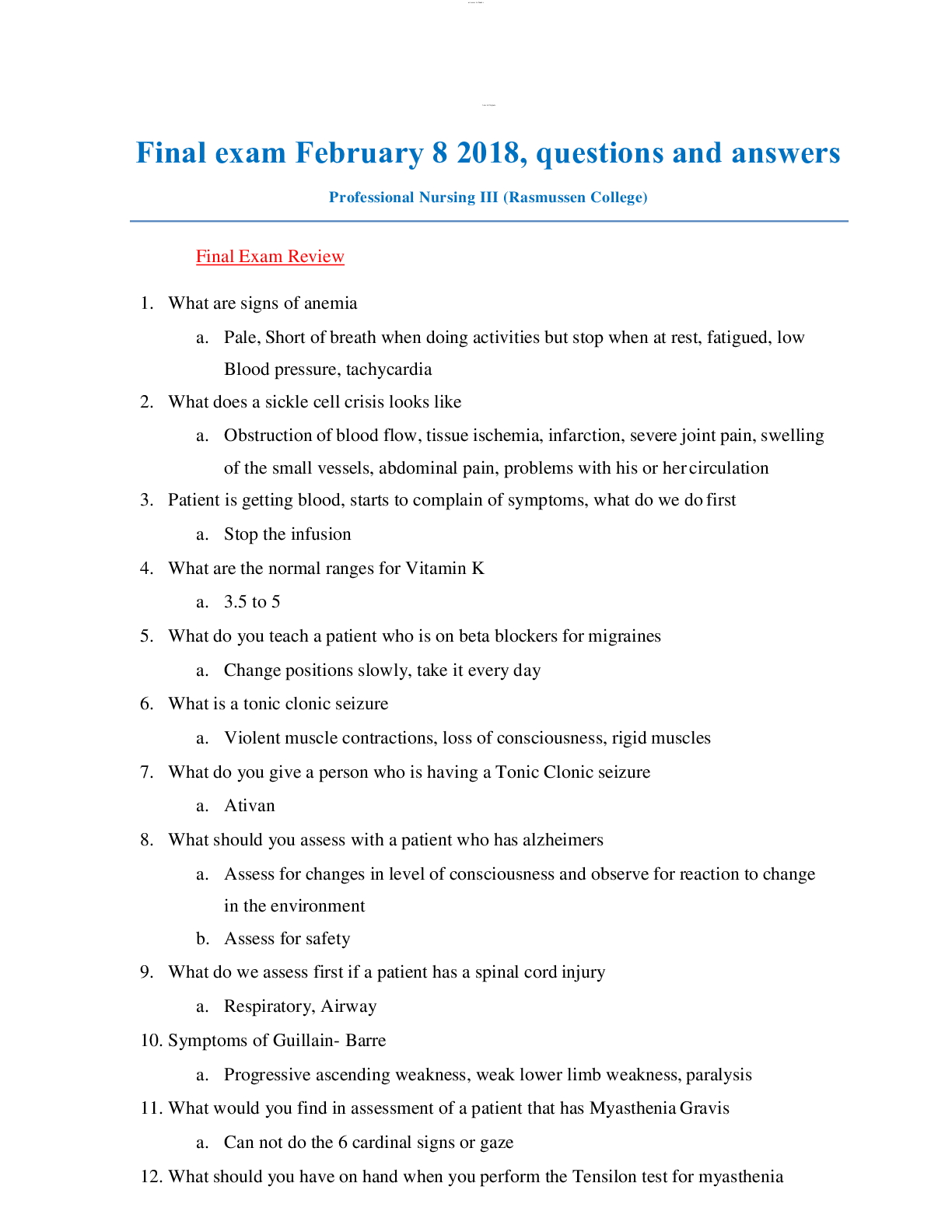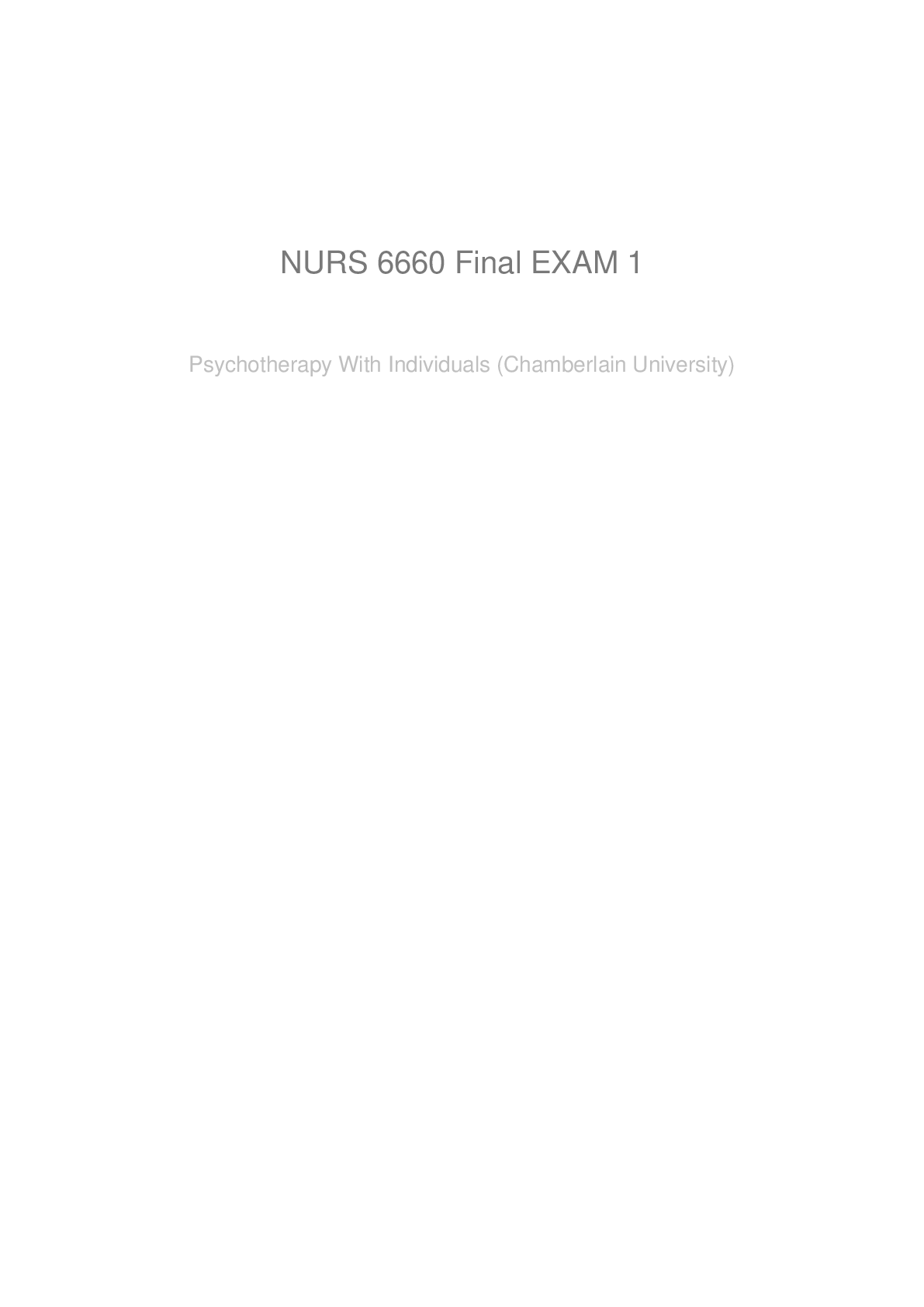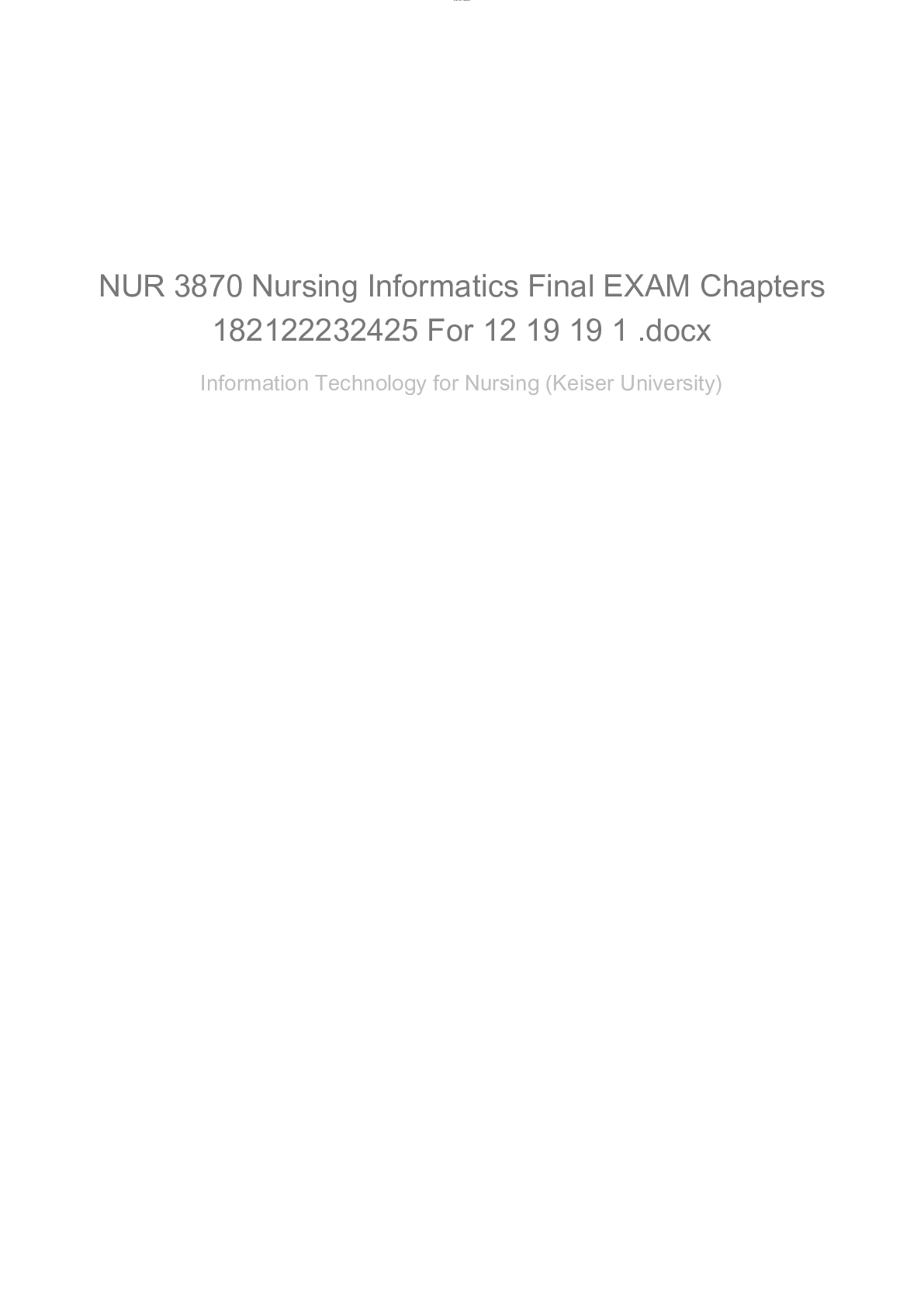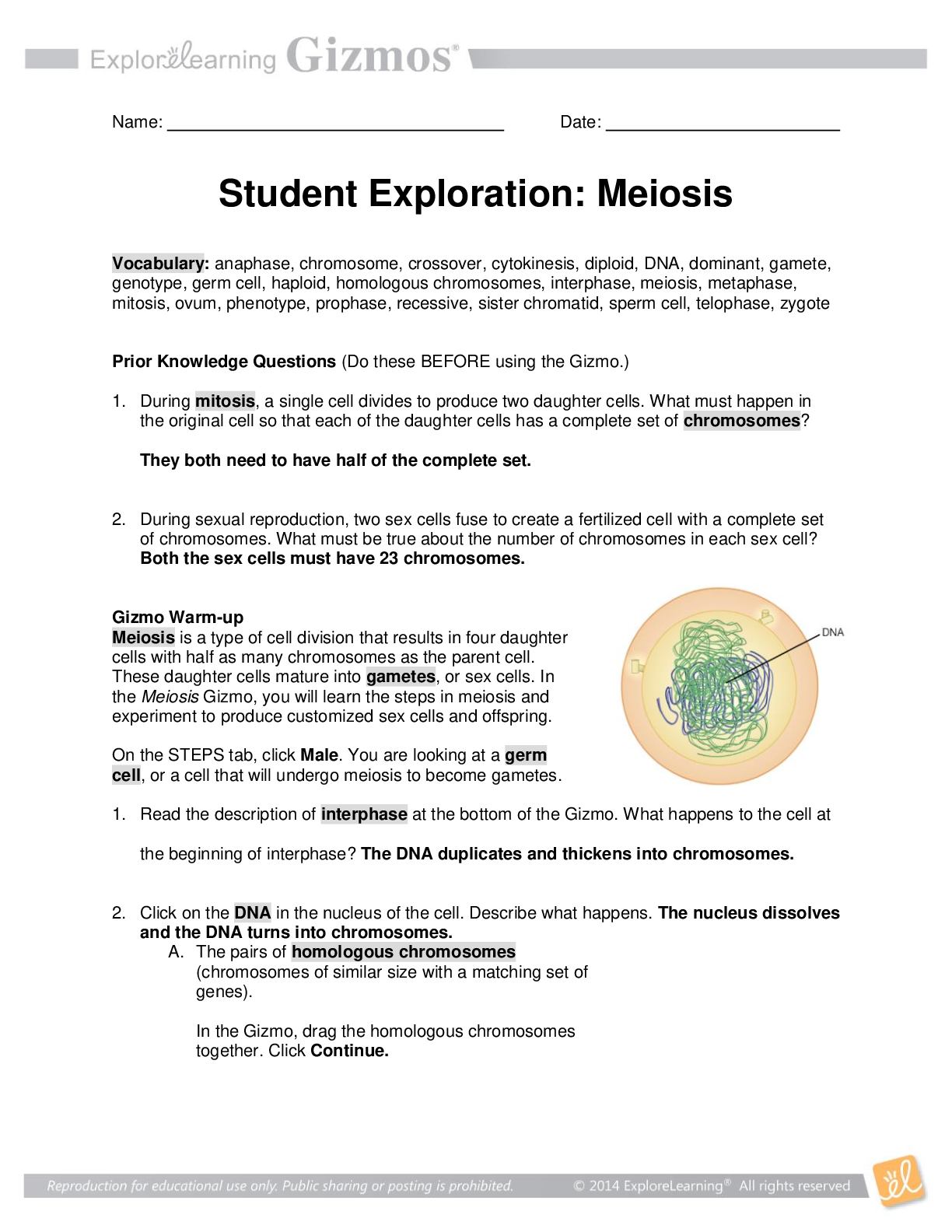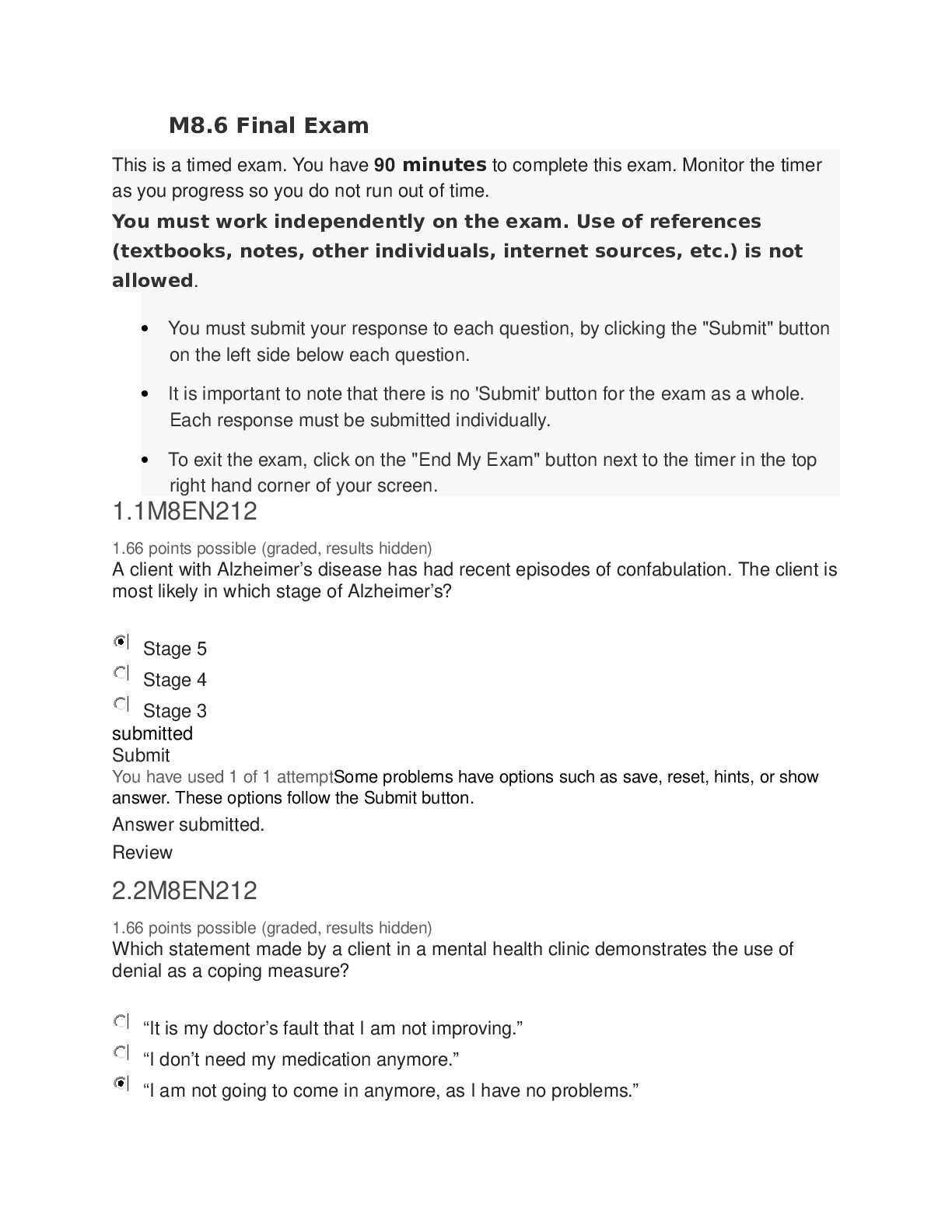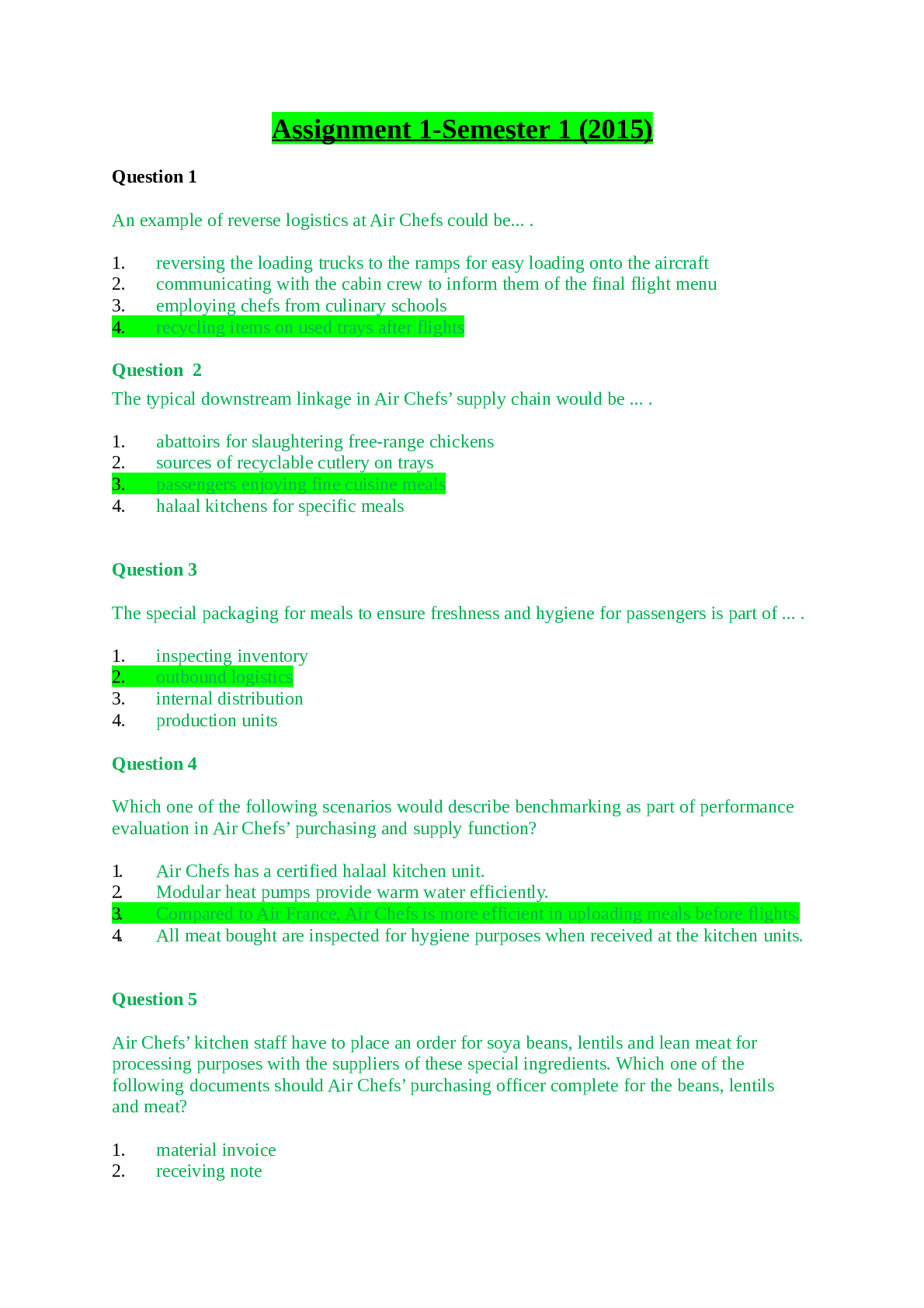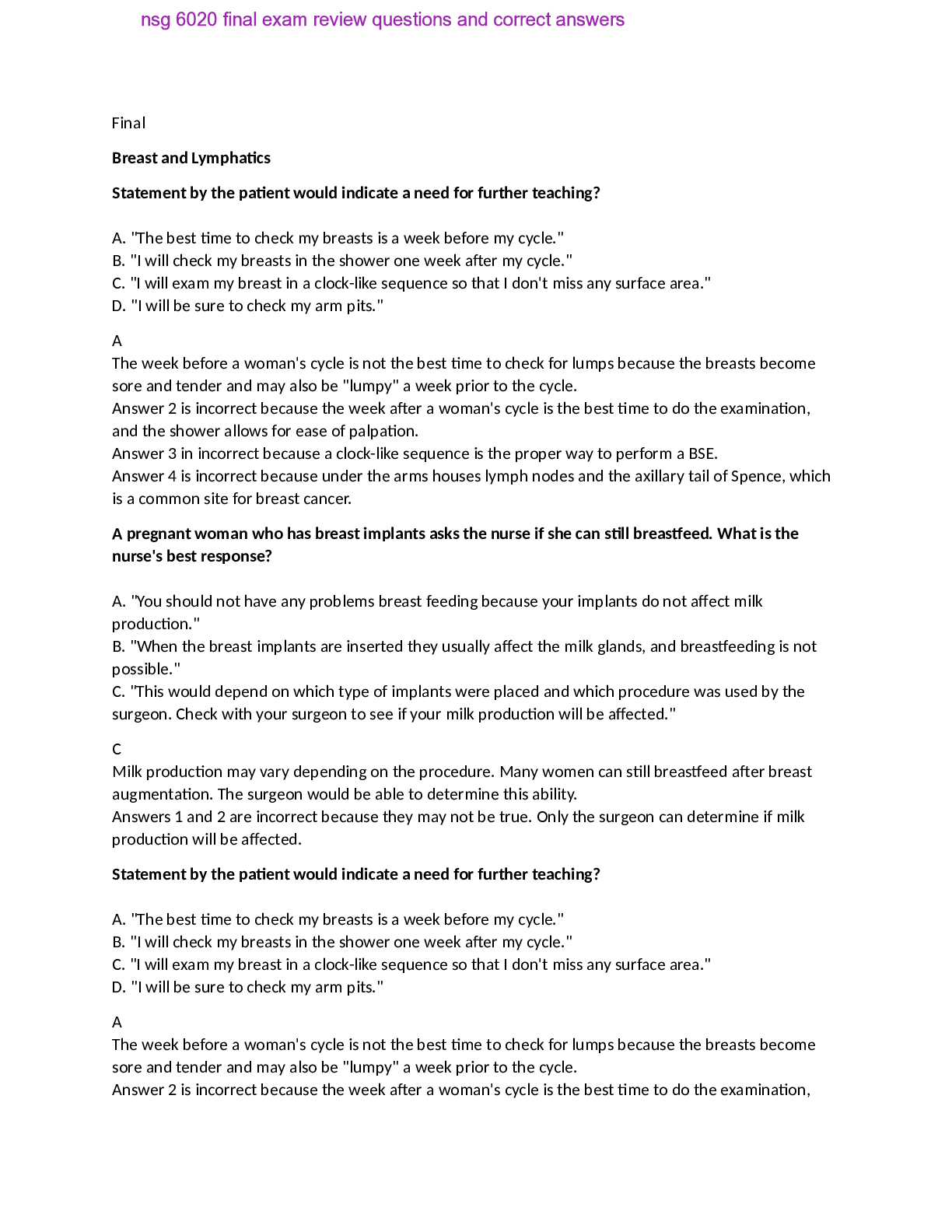Medical Studies > Final Exam Review > Diabetes/GI System & Disorders Exam Review Guide to A+ (All)
Diabetes/GI System & Disorders Exam Review Guide to A+
Document Content and Description Below
I. DIABETES: Function of Pancreas: o Secretes Insulin 2 Types of Diabetes: o Mellitus and Insipidus 3 Types of Diabetes Mellitus: o Type 1, Type 2, and gestational o More prevalent ... in men than women o Occurs more in African Americans and Hispanic populations o Has wide ranging systemic effects and is a contributing factor to the development of cardiovascular disease, hypertension, kidney disease, neuropathy, retinopathy, peripheral vascular disease and stroke. Role of Insulin: o Insulin allows for the metabolism or uptake of glucose into the body’s cells. Type 1 Diabetes Mellitus: o A metabolic disorder resulting from inadequate production of insulin. o An autoimmune dysfunction involving the destruction of beta cells, which produce insulin in the islet of Langerhans of the pancreas. o No insulin is produced by the pancreas o Usually genetic/inherited and occurs early on in life, child diabetes o Viruses- destruction of beta cells o Auto antibodies against insulin o Pathophysiology: Stages – Genetic predisposition – Environmental Trigger – Active Autoimmunity – Progressive Beta cell destruction – Overt Diabetes Mellitus Type 2 Diabetes Mellitus: o A progressive condition due to increasing inability of cells to respond to insulin (insulin resistance) and decreased production of insulin by the beta cells. o Insulin production is less or use is impaired or reduces insulin sensitivity o Hereditary – major role o Linked to obesity, sedentary lifestyle, diet, and hereditary o Pathophysiology: Causes – leading to high glucose Stages – Desensitization – Failure of beta cells to respond to high glucose levels Insulin Resistance – Production of glucose by liver despite of high glucose levels Inability of fat and muscle tissue to take up glucose – peripheral insulin resistance o These patients usually have blood glucose levels around 160 o Insulin takes the glucose into the cell, as well as potassium because they follow each other, where it can be metabolized and used. o Patient Teaching: Eat healthy (1200 calories/day maximum, eat smaller more frequent meals), exercise 30-45 mins a day, get away from sedentary lifestyle, take oral antidiabetic medications, and then if these interventions don’t control the diabetes, then give insulin. o 3 P’s of hyperglycemia of type 2 diabetes: Polyurea, polydipsia, polyphagia Polyuria: Excessive urination Polydipsia: Excessive thirst Polyphagia: Excessive hunger o Diagnostic Methods: HgbA1C or give patient glucometer and have him record his glucose levels for 3 days and report (cheaper than A1c), run lipid profile, CBC, CMP, RLT, check eyes for glaucoma, check toes for neuropathy, wounds that do not heal? Frequent infections? Clinical manifestations plus high glucose = Diabetic Gestational Diabetes: o Occurs during a woman’s pregnancy and usually goes away after birth o Pregnant woman also experience the 3 P’s, so run OGTT (oral glucose tolerance test): fasted over night, take her blood, then give her 100mg glucose, then take her blood after 30 mins and 2 hrs o Pregnant women get OGTT, not HgbA1C Clinical Manifestations: o Hyperglycemia S/S: Fatigue, Blurred vision, Slow wound healing, Itchy skin-“Hot and dry, blood sugar high”-3 P’s o Hypoglycemia S/S: Sweating, Hunger, Trembling, Anxiety, Confusion, Blurred vision-“Cool and clammy, need some candy” o Weight loss o Ketone bodies- Diabetic Keto Acidosis o Fruit breath odor, headache, N,V, Abd. Pain, fatigue, weakness, slow wound healing o Nonspecific symptoms Classic symptoms of type 1 may manifest o Fatigue o Recurrent infection o Recurrent vaginal yeast or candida infection o Prolonged wound healing o Visual changes Complications of Diabetes: o Neuropathy: Caused by damage to sensory nerve fibers resulting in numbness and pain Is progressive, can affect every aspect of the body, and can lead to ischemia and infection Provide foot care, lotion on feet (not toes), powder in toes, trim nails straight, and put powder in between toes, and buy larger sized shoes Neuropathy - Desensitization of peripheral nerve endings. Microvasculature that supplies nerves is damaged Due to decreased circulation, myelin sheet is damaged Nerve conduction is reduced o Nephropathy: Damage to the kidneys from prolonged elevated blood glucose levels and dehydration Increased polyuria, Glycosuria and changes in kidney vasculature leads to renal failure. Monitor BP, hydration, kidney function (I&O) Teach the client to drink 2-3L/day fluid, avoid soda, alcohol and NSAIDS o Retinopathy: Impaired vision and blindness Cause hemorrhages in blood vessels of retina and cotton wool spots Encourage yearly eye exams and management of blood glucose levels Ophthalmic vasculature is damaged Abnormal blood vessels proliferate and hemorrhage, clouding vision and destroying the retina o Circulatory Complications Hypertension, MI, and stroke Monitor BP Encourage cholesterol level checks, exercise, weight loss, good diet/dietary consult o Delayed Wound Healing: Development of gangrenes – FOOT CARE o Risk of infection: Increased glucose and decreased nerve supply - Hub for bacteria Opportunistic Infections – yeast, Candida Circulatory Complications: o Heat and blood Vessels diseases – Stroke, Heart Attack, CAD Microvascular complications: Retinopathy and/or nephropathy Macrovascular Disease: Peripheral Artery Diseases Diabetic Ketoacidosis: o Acute, Life threatening condition characterized by increased blood glucose (>300 mg/dL) resulting in breakdown of body fat for energy, dehydration, metabolic acidosis, and accumulation of ketones in the blood and urine. o Onset is rapid and high mortality rate. o Risks – Uncontrolled diabetes, missed insulin, stress, illness, trauma, increased steroids/epinephrine’s o DKA occurs acutely, and needs to be treated within 20 minutes o Give IV asap, give them bolus for dehydration 500ml/hr normal saline Hyperglycemic-Hyperosmolar State (HHS): o HHS – Acute, life threatening condition characterized by profound hyperglycemia (>600 mg/dL) that leads to dehydration but absence of ketosis. Onset is generally over several days. o HHNKS (Hyperosmolar Hyperglycemic Non-Ketotic Syndrome) o Non-ketotic syndrome takes longer to develop than DKA (several days) Treatment of HHS and DKA: o Treat the cause – infection/stress etc o First rapid Isotonic Fluid – followed by Hypotonic fluid o Monitor Vitals, Urine, Weight o Goal – Glucose – 250 – then start adding glucose to fluid o Regular Insulin – First Bolus – then IV o Monitor Potassium – First Hyper then Hypo o Cardiac Rhythm o Sod Bicarb if Acidosis o Do regular assessment, take CBC, ABG panel, then give fluids, don’t give anything NPO o When glucose goes down to 400, slow the insulin and fluids, once glucose goes to 280 stop the insulin Diagnosis: o Fasting Blood Glucose or HbA1c Nursing actions: Hold antidiabetic medication until after blood is drawn. Client education: NPO 8hr. prior test. o Oral glucose tolerance test (OGTT): Nursing actions: Not a routine test 3 blood samples: o Fasting, then q 30min for 2 hr. (after glucola) Client education: Balanced diet x 3days NPO 10-12 hr. prior test. Only water during test. o Glycosylated Hb (HbA1C): Normal : 4-6% Diabetics: 6.5-8% (target goal <7%) average BG for the past 120 days. Client education: Tx. Effectiveness & compliance. Quarterly or twice a year o Urine Ketones: >300 mg/dL associated with hyperglycemia Medical emergency o Other Notes: For a type 1 patient feeling feverish, drowsy, nauseas, with ketones in blood, with glucose around 350, eat, use the sliding scale, drink a lot and check glucose in 2 hrs. If ketones go away, then you’re good, but if the ketones are still present, bring patient into ER (try to manage as much as possible before admitting them) Assessment: Lab Tests o Lab Tests: o Diagnostic criteria include: • TWO findings (on separate days) of at least one of the above mentioned tests, OR • ONE of the above positive test + manifestations of diabetes Specimen Collection for Glucose Monitoring: o Site selection: Most common site? Finger tips Alternate sites? o Clean site with soap and water (NOT ALCOHOL) o Wipe away first drop of blood Self-Monitoring of Blood Glucose: o Client Education – Check the accuracy of the strips . Use the correct code number in the meter to match the strip bottle number. Store strips in the closed container in a dry location. Hand hygiene. Obtain an adequate amount of blood sample Use fresh lancets Avoid sharing equipment to prevent infection. Keep a record of the SMBG (Self Monitoring of blood glucose) that includes time, date, serum glucose level, insulin dose, food intake, and other events such as activity level or illness. o For an accurate reading, you need to make sure the patient has fasted for 6-8 hours and did their normal routine, and didn’t do anything different like exercise or start a new diet. Medical Management of Diabetes: o INSULIN: o Promotes cellular uptake of glucose (decrease glucose levels) o Converts glucose into glycogen o Move K+ into cells o Uses: Type I, and some patients with Type II, and gestational diabetes o RAPID-, SHORT-, INTERMEDIATE-, AND LONG-ACTING o **Oral Hypoglycemic Agents – Discussed in Pharmacology Insulin Types and Characteristics: o We expect the patient to be hypoglycemic during the peak hours, when insulin levels are the highest, the glucose is lowest. o If a patient gets insulin and does not eat, then you're going to be hypoglycemic and pass out. o Goal is to keep diabetic patients glucose between 120-130 o RN-mix regular (clear) then NPH (cloudy) and (inject air into NPH first then R) o Insulin ratio:70 (N)/30 (R) o Regular insulin is for Postprandial- 2 hrs after meal (less than 200-220) o U100- only regular insulin which can be mixed and pushed IV (not U500) [Show More]
Last updated: 1 year ago
Preview 1 out of 27 pages

Reviews( 0 )
Document information
Connected school, study & course
About the document
Uploaded On
Jul 03, 2021
Number of pages
27
Written in
Additional information
This document has been written for:
Uploaded
Jul 03, 2021
Downloads
0
Views
87


